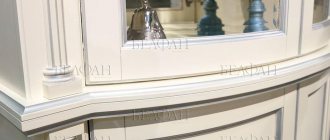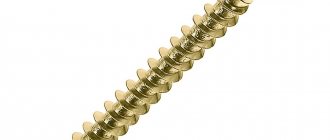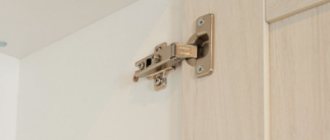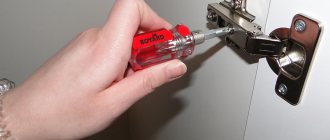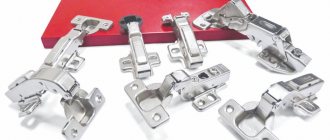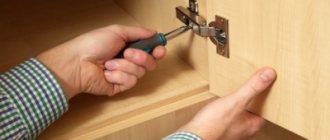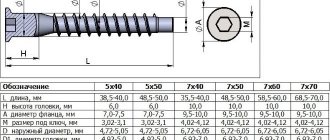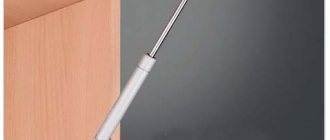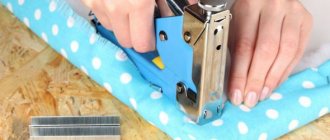Advantages and disadvantages
A hidden furniture hinge differs from, say, ordinary overhead, corner or card hinges. First of all, because it is practically invisible, which gives the door appearance elegance and aesthetics. Secondly, such a door opening mechanism differs in its installation features.
Here are the advantages and disadvantages they have.
| Advantages | Flaws |
| Aesthetics, inconspicuousness | Labor-intensive installation |
| Easy to adjust | High price |
| Universality - there is no division into right and left | Difficulty removing the door |
Such an advantage as aesthetics can be called controversial, because the hinge on the cabinet door is already invisible from the outside. But it can be noted that such a hinge will not interfere when the door is open, for example, when tidying up a cabinet or cabinet, you cannot get caught on it, tear clothes or break the hinge itself.
The complexity of installation is also a controversial issue, because in most cases we purchase furniture already assembled, which means that we will not have to deal with installation in any case. This is only relevant when making or assembling a furniture set yourself.
Characteristics
Hidden furniture hinges are popular due to their aesthetics. According to the type of construction, they are classified as hinged hinges. The hinge is located inside the structure and is invisible from the outside.
Doors with such hinges can withstand the same loads as those equipped with overhead hinges, while easily opening, closing, and also being fixed in the desired position. Their fastening has increased strength, which prevents spontaneous separation of the door from the body. Since the structure is located in the door vestibule, it is more difficult to reach and, therefore, break.
Due to the hidden location of the hinges, you need to take into account that they will be more difficult to clean from dust or lubricate. However, cleaning must be done regularly. Dust accumulating in the mechanism makes it difficult to open and close the door and can lead to structural failure.
The main characteristics of such accessories include:
- aesthetics;
- quick fixation in the desired position;
- high strength.
There are a lot of options for devices of this design, so you can choose any one, taking into account all the consumer’s requirements.
Manufacturing materials
The durability of furniture fittings, including the quality of hidden hinges for furniture, determines its uninterrupted service life. Therefore, when purchasing both a ready-made set and components for self-assembly or manufacturing, you need to pay close attention to the material from which all fastening mechanisms are made.
The hidden furniture hinge is made of metal alloy. This alloy is called Zamak, or TsAM (after the first letters of the metals it contains). It is a mixture of aluminum, magnesium, zinc, copper. It is characterized by high strength, wear resistance, smooth matte or shiny surface, and is absolutely safe for humans.
Other furniture fittings, fasteners and mechanisms are also made from this alloy. The top is often covered with brass or nickel-plated connections. In addition, it is possible to manufacture furniture hinges from metal with plastic elements.
Features of installing furniture hinges located inside the door
The door hardware comes with instructions that describe the installation sequence in detail. Installation of furniture hidden hinges does not require special skills and knowledge. For high-quality insertion, it is enough to follow basic rules and simple recommendations from the manufacturer. First you need to study the mechanism of the product and read the instructions. Next, you should prepare for work.
Installation sequence:
- It is important to ensure that you have the necessary tools;
- Marking is in progress;
- Drilling is carried out in accordance with the marks;
- Installation and adjustment of hinges.
Before starting work, you must immediately anticipate all the subtleties of installation. Marking is carried out in accordance with certain rules. If you make a mistake, the doors will overlap each other or a large gap will form. The hinges must be on the same axis. To ensure accuracy, use a building level.
Scope of application
A metal semicircular hidden furniture hinge of small sizes is most often used for furniture fronts in kitchen sets or wardrobes. Larger, more massive, durable fastening mechanisms are used for interior or entrance doors. They also use hinges with an unusual structure and original design. These options are more expensive than usual.
For these purposes, non-adjustable hinges are usually used. Adjustable ones, with additional screws intended for this purpose, are found in standard bedside tables and cabinets.
When choosing a hidden hinge for your furniture, you should pay attention to its dimensions and find out how much weight it can withstand. Kitchen cabinets and cabinets usually have lightweight doors, so the hinges may be small. To secure the wardrobe door, you should choose a more massive one. But it is better to install this fastening mechanism if you have experience in such matters. If not, then it is safer to contact a specialist.
Varieties of four-hinged furniture hinges for cabinets
The list of functional capabilities of furniture hinges is very large; they can be installed on cabinets made of various materials and of different, non-standard designs. Conventionally, all furniture hinges for cabinets can be divided into the following types.
According to the position of the door relative to the side wall
Regarding how the facade will cover the sides of the cabinet, three types of furniture hinges can be distinguished.
| Overhead furniture hinges - the door completely covers the end of the side of the cabinet | |
| Inset (internal) furniture hinges – the end of the cabinet body is completely open. | |
| Semi-overlay furniture hinges - the end of the body at the place where the canopy is attached is half hidden by the facade. |
By type of façade and body material
Separately, we can distinguish another type of furniture hinges with installation on glass facades and with a frame made of metal profiles.
For “thick” facades made of laminated chipboard, MDF and wood, special reinforced furniture hinges with a deeper bowl and a long arm are produced to allow the door to be moved beyond the thickness of the body.
By installation method
There are three types of furniture hinges, depending on the design and installation features with subsequent adjustment. The differences are obvious at the junction of the hinge body and the strike plate.
| Slide-on - the hinge body is inserted with a slot to look like an installed striker and is fixed in the desired position. |
| Clip-on – the hinge body is inserted into the groove of the installed strike plate, fixed by pressing, and adjusted with a fastening screw. |
| Key-hole - the hinge body with a hole is placed on the installed striker and is inserted under it with a translational movement until it reaches a fixed position. |
By bowl diameter
Most four-hinge furniture hinges have a bowl with a diameter of 35 mm. There are so-called “mini-loops”, in a more compact design, with a bowl diameter of 22-25mm.
With different opening angles
| A more complex design of the furniture hinge body can provide a larger opening angle, up to 165-170 degrees versus the standard 90-105 degrees. These types of furniture hinges are called “transformers”. |
Also in everyday life you can find the names “crocodile” and “crab”.
Furniture hinges with closer
You can read more about furniture hinges for cabinets with closers here. The mechanism itself for smoothly “pulling” the facade into the closed state can be built into the mechanism or overhead. In the first case, you should immediately buy furniture hinges with a closer, in the second, you can purchase it separately and install it on existing hinges (if the manufacturer has provided such an upgrade option).
Furniture hinges for corner cabinets
The design of the cabinet box can be corner or end, with various features and non-standard solutions. Furniture hinges for corner cabinets allow you to equip the facade with almost any type of furniture with an angle increment of 5 degrees.
In some design cases, the installation of a hinge requires the provision of special strips to make the angle “correct”, close to 30, 45, 60, 90 or 170 degrees.
When choosing opening mechanisms, be sure to pay attention to the installation diagram. Some manufacturers use the designation “negative angle” in the article number (for example, -30 degrees). And others add the value to 90 for the same positions (for example, not -30, but 120 degrees).
Let us highlight the main types of furniture hinges for corner and end cabinets in tabular form, including those that are used to open facades attached to false panels and to each other, “accordion-style”.
| Adit (straight) loop for false panels. | |
| For corner kitchen cabinets with 45 degree fronts. | |
| For a beveled (end) kitchen cabinet with a -45 degree front. | |
| For corner cabinets with fronts at 30 degrees. | |
| For a beveled (end) cabinet with a facade at -30 degrees. | |
| Carousel hinge for L-shaped accordion cabinet door. |
